The Microsoft Surface Laptop 2 Review: Surface Essentials
by Brett Howse on March 28, 2019 8:00 AM EST- Posted in
- Laptops
- Microsoft
- Surface
- Surface Laptop
- KBL-R
- Surface Laptop 2
GPU Performance
Intel’s UHD 620 iGPU is pretty well known by now, offering 24 execution units and a great video decoder. Where Intel lacks the grunt for 3D gaming, they do make it up in battery life, especially on video playback. But there is no getting around the fact that it offers relatively little in the way of 3D performance.
With some extra competition here now in the guise of AMD’s Ryzen platform with integrated Vega, hopefully we’ll see some fresh ideas from Intel in the near future. A few players, such as Huawei, have skirted the issue by adding a NVIDIA GeForce MX class GPU, but the added cost and complexity of that is not something that many manufacturers have gone. Microsoft does offer some serious GPU performance in their Surface Book lineup, featuring either a GTX 1050 or GTX 1060, but in the Surface Laptop 2 it’s just the UHD 620.
3DMark
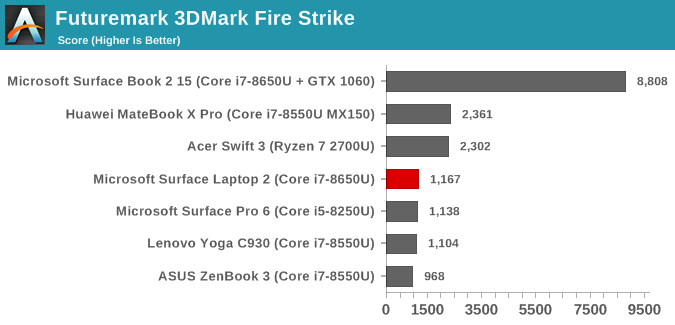
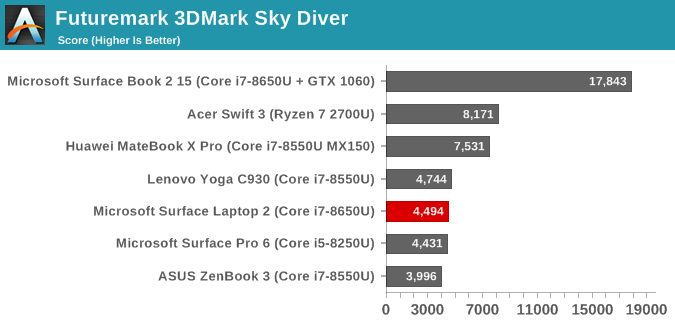
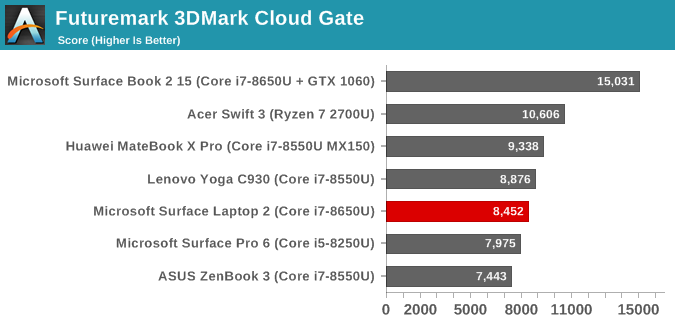
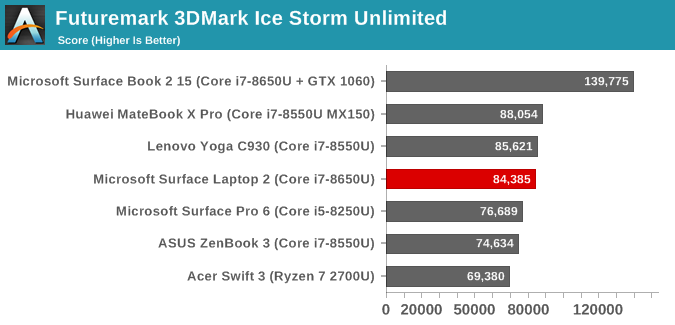
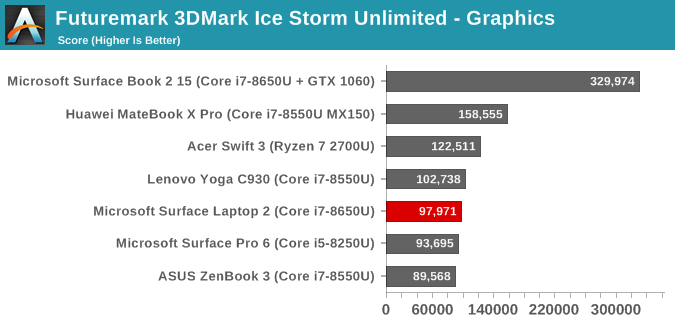
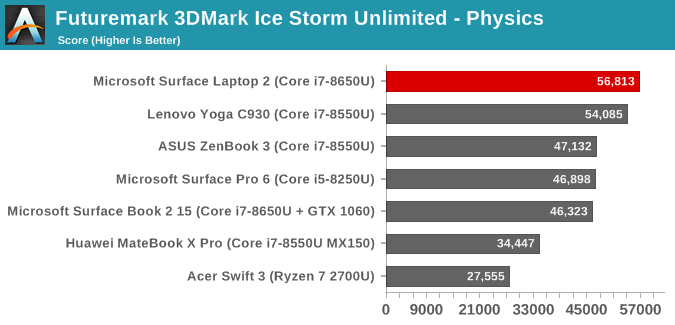
3DMark offers several scenes with increasing levels of complexity to test a wide range of GPUs. Fire Strike is the highest level we test on laptops, followed by Sky Diver, Cloud Gate, and Ice Storm Unlimited which is a test that can also be run on smartphones and tablets, although the results are not directly comparable. As the scene complexity goes down, CPU performance is more important.
On Fire Strike, Intel’s UHD 620 is really unusable, scoring under half of an AMD Ryzen powered laptop, or the MX150 in the Huawei MateBook. Those results continue, but as noted above the devices get more CPU limited as the scenes get less complex, which is why you can see the UHD 620 outperforming Vega on Ice Storm Unlimited.
GFXBench
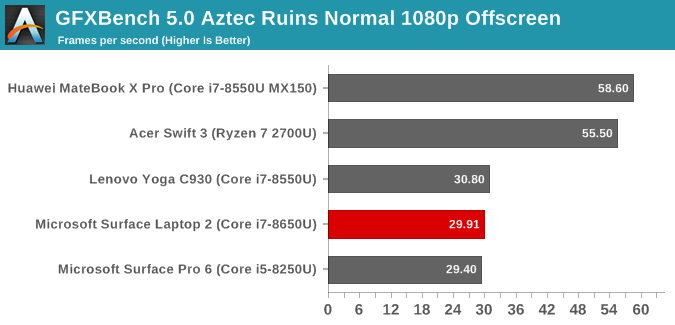
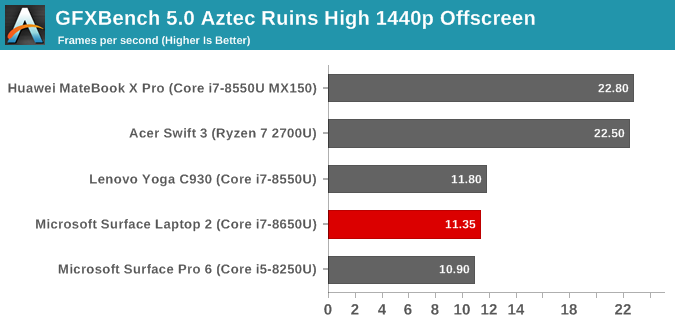
With version 5.0 of GFXBench, Kishonti now offers DX12 benchmarks, which is great to see. The previous version used OpenGL which is all but gone from the PC landscape, and not relevant. As expected though, UHD 620 is well behind AMD’s Vega or the MX150.
Dota 2
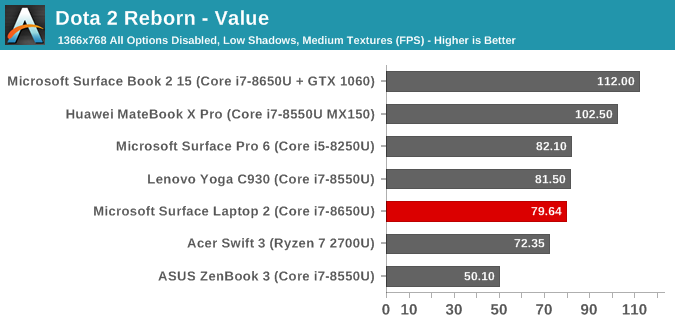
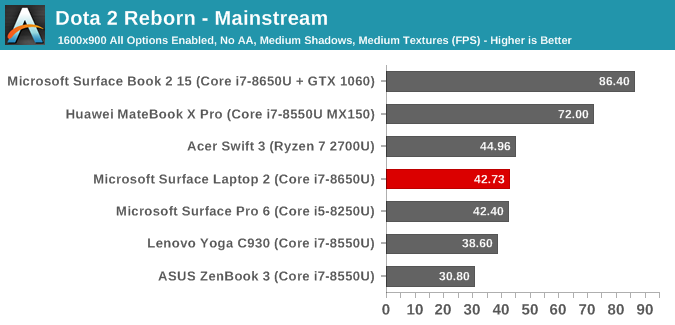
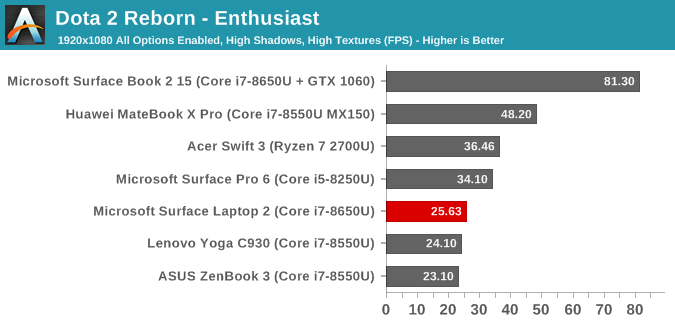
Valve’s Dota 2 offers a wide range of performance options which allows it to run well enough on even integrated graphics, assuming you’re OK turning the options down. The game tends to be CPU capped with any real GPU though, which is why a GTX 1060 compares to a MX150 on value settings. The Surface Laptop 2 doesn’t offer any surprises here though. It’s very playable on value, somewhat playable on mainstream, but unplayable on enthusiast.
GPU Conclusion
The Surface Laptop 2 isn’t a gaming system by any means. The 3:2 aspect ratio can be funky on some games, and only offering Intel’s UHD 620 holds it back quite a bit. It would have been nice to see Microsoft add something like the MX150 to this for a performance bump, but if you do need some GPU performance they’d likely rather sell you a Surface Book.
Storage Performance
Microsoft made the move to BGA SSDs a while back, and that continues with their Laptop 2. The review unit features a SK Hynix BC501. The advantage of a BGA SSD is size. The BGA drive is just 16 mm x 20 mm, compared to a typical M.2 2280 which is 22 mm x 80 mm. The BGA model is much thinner as well, so it makes for easier packaging, at the cost of not being able to replace or upgrade the drive later. If you are looking for any Surface device, be aware that you need to purchase your storage up-front.
The other disadvantage is that the BGA models only offer a PCIe x2 link, rather than the typical x4 link you’d see on a mid-to-high-end M.2 drive, which limits the maximum bandwidth to half of what we might see elsewhere. In real-world use, that’s not too limiting, since random reads and writes never max out the interface anyway, but it does mean that sequential speeds are capped. Even so, it’s still an order of magnitude faster than any spinning drive.


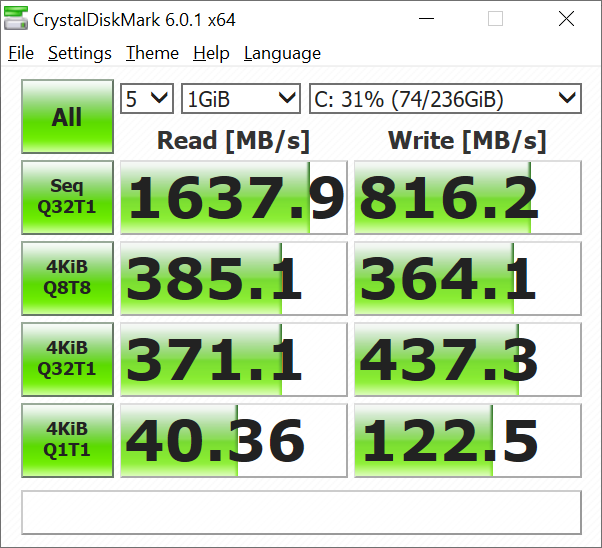








59 Comments
View All Comments
sorten - Thursday, March 28, 2019 - link
If I absolutely needed a laptop today I'd probably pick up a used one so I could wait for the Ice Lake CPUs from Intel this fall. It would be a shame to buy such nice hardware only to find yourself two significant generations behind within 6 months.yankeeDDL - Thursday, March 28, 2019 - link
I hope you're right. Intel has been caught sleeping, and the improvements since SkyLake have been, frankly, anecdotal. It seems that AMD, by making a small core, designed from the ground up to work in tandem with other cores, has a much more effective/scalable architecture. So a 4-core, 8-thread CPU from AMD, while providing slightly lower IPC, today, is much more effective than a 4-core, 8-thread CPU from Intel.Let's see if ICL brings real benefits. The 10nm node should help a lot.
smilingcrow - Thursday, March 28, 2019 - link
"So a 4-core, 8-thread CPU from AMD, while providing slightly lower IPC, today, is much more effective than a 4-core, 8-thread CPU from Intel."I thought AMD currently has lower IPC + lower clock speeds so how exactly are they more effective?
With Ryzen3/Zen 2 due in the summer this may change but for now AMDs advantage is more cores per buck.
niva - Thursday, March 28, 2019 - link
I'm assuming he meant in terms of price/core, but that's just a guess.Doesn't AMD have a big problem with power consumption in mobile CPUs though? I've read that the AMD laptops out now suffer from big power drain even if performance wise they're equivalent or batter than the Intel chips at the same price range.
Irata - Friday, March 29, 2019 - link
Supposedly in idle only, but I do not really see that on my Matebook. Then again, I do not let it sit idling for hours on battery since it boots so quickly that there is no reason for that.In normal use (web / video), the battery indicator does not move much at all.
What many forget is that even with Intel based laptops, there are sometimes big differences between models or manufacturer, depending on the battery size and how well they configured their laptop. The ones that aren't well done are not the ones you usually see in comparison tests though (as there are more models to pick from vs. AMD based ones).
lightningz71 - Monday, April 1, 2019 - link
Their big problem was definitely low power states management on the 2X00u series of chips. The 3x00 series chips that are now hitting the market make up a lot of ground in that regard, both with the chips themselves and better bios/uefi implementations by the vendors that are building the systems. Add in the fact that AMD has finally decided to take the lead on providing a stable, performant drivers for the video section of the chips, and you can largely ignore the abysmal efforts of the vendors themselves to provide quality, updated drivers themselves.For the money, some of the low end AMD 2x00u series laptops gave you MUCH more bang for your buck than the equivalent intel based offerings. The few limitations that people who purchased them did come across could be overcome through software tools by those that it actually mattered to (power and performance management profiles could be tweaked by certain software tools that allowed systems to maintain higher boost states longer and better manage their thermals).
I can't wait to see some of the more thorough write-ups on the latest 3x00h series laptops that are fast enough in both core performance and graphics performance to go up against comparable intel based machines that also include an Nvidia MX1xx series dGPU with an i5. They should technically be less expensive, offer similar performance and be more power friendly when pushed to their limits. This isn't to say that they won't have their flaws, just that, dollar for dollar, on the low end, you'll get more with the AMD system.
Manch - Friday, March 29, 2019 - link
Superior SMTsmilingcrow - Friday, March 29, 2019 - link
IPC includes the whole chip performance so they are still behind.Zen currently makes sense to me if you want 8 or more cores so hopefully with Zen 2 they will compete from 4 cores upwards.
Manch - Monday, April 1, 2019 - link
IPC refers to the perf of a single core usually. Generally has an advantage of about 8-10%. That advantage disapears when using SMT/HT. AMD has the more efficient design so it makes up for that 10% deficit. Throw in multiple core and it starts to win. TBS even now a lot of software is optimized still for Intel but thats changing rapidly. Intel still has a clockspeed advantage. Where as Zen has a pretty hard wall @4.3, Intel can get on down the road a good bit faster. Especially with 4 core chips. I dont think that advantage will last too much longer. Between the mitigations from ME/SPec, and lack of new architecture, Intel seem to be pushing cores over HT now to keep its advantage short term. AMD put out a competitive chip, Intel has yet to fire back like it did with Core against Athlon XPs(Those were the days!) Theyre just stretching their long in the tooth Core. Something is waiting in the wings though.smilingcrow - Monday, April 1, 2019 - link
From what I've seen a 6C/12T Intel beats a similar spec AMD easily.I've read that AMD's HT gives a bigger boost than Intel's but that still isn't enough for it to catch up due to it being too far behind in other areas.
So it's about as meaningful in the real world as a purely synthetic benchmark.
That should change soon with Zen 2 so there will be no need to live the life of a fantasist then.